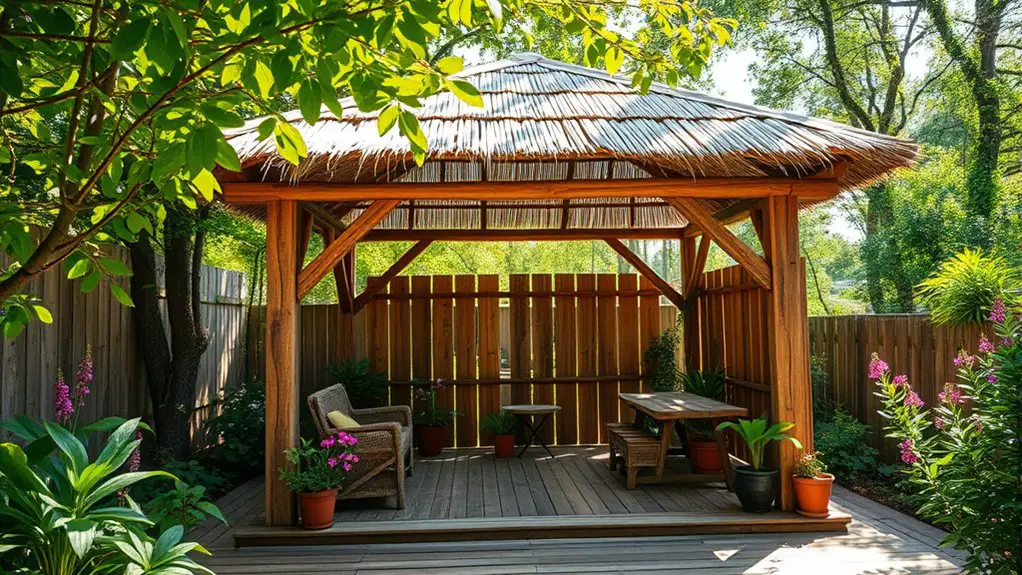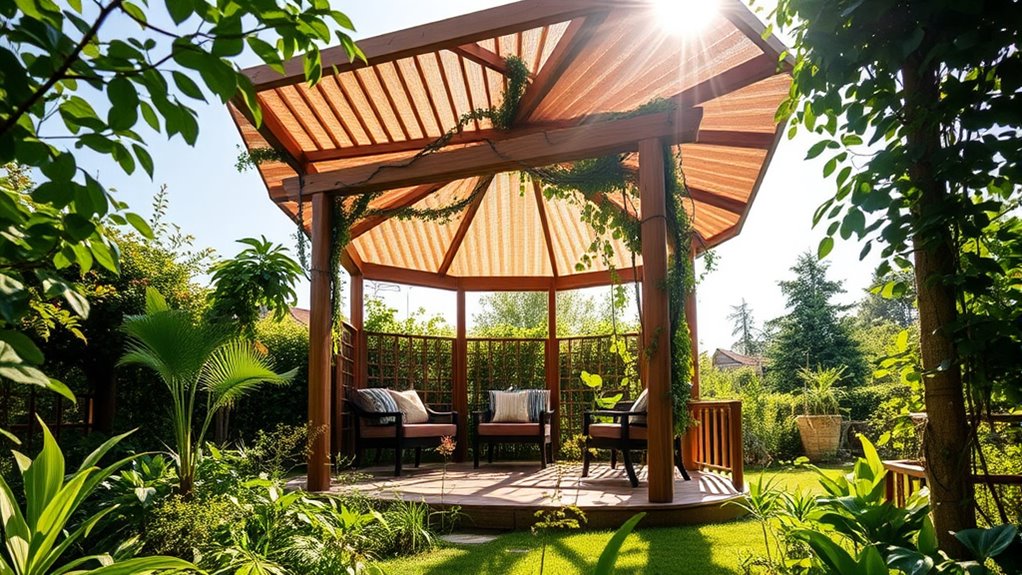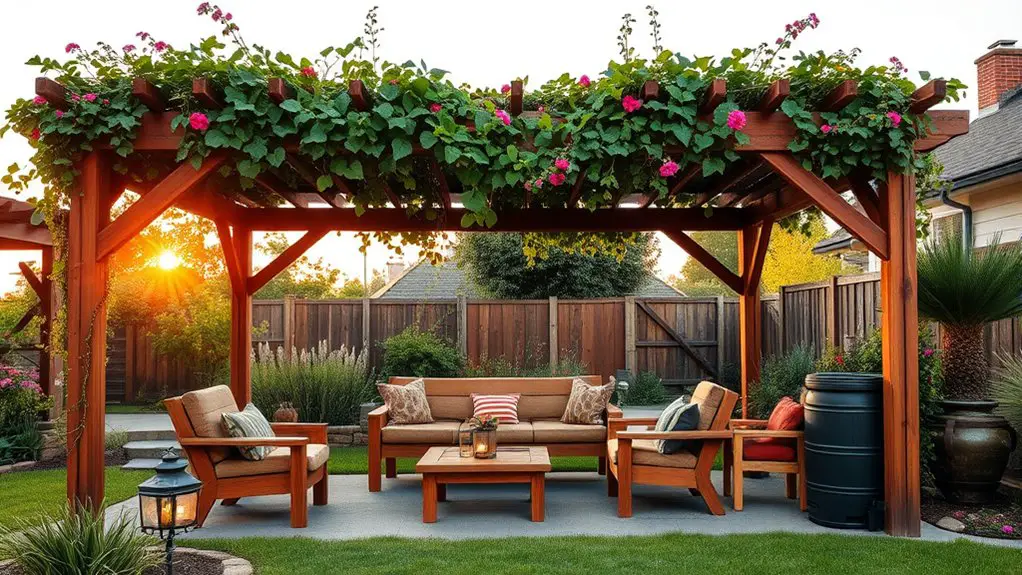To reduce your carbon footprint with an eco-friendly gazebo setup, start by choosing sustainable materials like bamboo and recycled wood. Incorporate renewable energy sources such as solar panels or small wind turbines for power. Design for natural ventilation and light to minimize energy use. Use eco-friendly furniture made from recycled materials, and implement water conservation practices like rain barrels and drought-resistant plants. Explore further to discover more strategies for creating your sustainable outdoor space.
Choosing Sustainable Materials for Your Gazebo

When setting up an eco-friendly gazebo, choosing sustainable materials is crucial for minimizing environmental impact. Opting for bamboo alternatives can be a game-changer; bamboo grows quickly and regenerates naturally, making it a top-tier choice for eco-conscious builders. However, if bamboo isn’t available, consider using recycled wood. This not only helps reduce waste but also adds character to your gazebo. When selecting recycled wood, look for certified sources to verify it’s been processed responsibly. Additionally, consider that certain wood types like cedar and redwood offer natural durability and resistance to decay, enhancing the sustainability of your structure. Think about the finishes you use as well. Non-toxic stains and sealants can protect your materials without releasing harmful chemicals into the environment. Remember, every choice you make contributes to the larger picture of sustainability. By consciously selecting bamboo alternatives and recycled wood, you’re not just building a gazebo; you’re creating a space that respects nature and champions freedom from unsustainable practices. Embrace these choices to make a lasting impact with your outdoor haven.
Incorporating Renewable Energy Sources
Incorporating renewable energy sources into your eco-friendly gazebo not only enhances its sustainability but also allows you to enjoy the outdoors with minimal environmental impact. By installing solar panels on the roof, you can harness sunlight to power lights, fans, or even small appliances, creating a self-sufficient space that reduces reliance on fossil fuels. If your gazebo is located in a windy area, consider adding small wind turbines to complement your energy system. These turbines can generate additional electricity, making your setup even more efficient.
Both solar panels and wind turbines are relatively easy to install and can be customized to fit your gazebo’s aesthetic. Additionally, using these renewable sources not only lowers your carbon footprint but also empowers you to live freely and sustainably. Embracing these technologies in your design helps cultivate an eco-conscious lifestyle while maximizing your enjoyment of nature.
Designing for Natural Ventilation and Light

To create a comfortable and inviting eco-friendly gazebo, it is vital to prioritize natural ventilation and light. Start by designing your gazebo with strategically placed windows and openings that promote natural airflow. This not only helps keep the space cool but also reduces the need for artificial climate control. Consider using adjustable louvers or screens that allow you to manage airflow according to your preferences.
Daylight optimization is another essential aspect. Position your gazebo to take advantage of natural light, using larger windows or skylights on the sunniest side. This minimizes reliance on electric lighting during the day, enhancing your connection to the outdoors. Additionally, incorporating light-colored materials can reflect sunlight, brightening your space without heavy energy consumption. Furthermore, selecting durable materials for your gazebo can contribute to its longevity and reduce environmental impact.
Using Eco-Friendly Furniture and Decor
Natural ventilation and light set the foundation for a comfortable outdoor space, but choosing the right furniture and decor can further enhance the eco-friendly atmosphere of your gazebo. Opt for pieces made from recycled materials, which help reduce waste and lower your carbon footprint. Look for furniture crafted from reclaimed wood or recycled plastics, offering both durability and style.
Supporting local artisans is another great way to make your space unique while promoting sustainability. By sourcing furniture and decor from nearby craftsmen, you not only reduce transportation emissions but also contribute to the local economy. Additionally, selecting furniture that complements your gazebo’s design can enhance its overall value and aesthetic appeal, making it a more inviting space for relaxation and entertaining.
Consider incorporating multi-functional pieces to maximize space and utility. For instance, a bench with storage can serve as seating and a place to stow outdoor essentials. By thoughtfully selecting eco-friendly furniture and decor, you’ll create a stylish and responsible environment that allows you to enjoy nature without compromise.
Implementing Water Conservation Practices

While creating an eco-friendly gazebo, implementing water conservation practices is vital for maintaining a sustainable outdoor space. By adopting these practices, you can enjoy your gazebo while minimizing your environmental impact:
- Rainwater Harvesting: Install a rain barrel to collect runoff from your gazebo’s roof. This stored water can be used for watering plants or cleaning outdoor furniture, reducing your reliance on municipal water sources.
- Drought Resistant Plants: Choose native, drought-resistant plants for your surrounding garden. These plants require less water, thrive in local conditions, and create a resilient ecosystem that attracts beneficial wildlife.
- Efficient Irrigation Systems: Consider using drip irrigation or soaker hoses to target water directly to plant roots. This method conserves water and guarantees your plants get the moisture they need without waste.
Frequently Asked Questions
How Can I Maintain My Gazebo Sustainably Over Time?
Maintaining your gazebo sustainably isn’t a hassle. Regular inspections and seasonal cleaning can prevent costly repairs. By staying proactive, you’ll guarantee your space remains enjoyable while minimizing waste and maximizing its lifespan for your freedom.
What Are Eco-Friendly Paint Options for My Gazebo?
When choosing paint for your gazebo, consider eco-friendly stains and natural sealants. They’re less harmful to the environment and help preserve the wood, ensuring your structure remains beautiful and sustainable for years to come.
Can I Use Reclaimed Materials for Gazebo Construction?
Absolutely, you can use reclaimed wood for your gazebo. It’s a fantastic choice for sustainable sourcing, reducing waste while adding unique character. Just make certain it’s treated properly to withstand the elements and maintain durability.
How Do I Ensure My Gazebo Is Bug-Resistant Naturally?
To keep bugs at bay, consider natural repellents like citronella or eucalyptus oil, and don’t forget mosquito netting. You’ll create a comfortable space, enjoying the outdoors without those pesky intruders ruining your freedom.
What Local Plants Can I Use for Landscaping Around My Gazebo?
When considering native plant selection for landscaping around your gazebo, choose species that thrive in your area. Sustainable landscaping not only enhances beauty but also supports local ecosystems, reduces maintenance, and conserves water.

